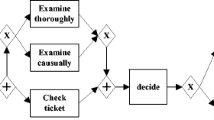Abstract
Resource allocation, as a crucial task of business process management, has been widely acknowledged by its importance for process performance improvement. Although some methods have been proposed to support resource allocation, there is little effort to allocate resources from the task preference perspective. This paper proposes a novel mechanism in which resource allocation is considered as a multi-criteria decision problem and solved by a new entropy-based clustering ensemble approach. By mining resource characteristics and task preference patterns from past process executions, the “right” resources could be recommended to improve resource utility. Further, to support dynamic resource allocation in the context of multiple process instances running concurrently, a heuristic method is devised to deal with resource conflicts caused by the interplay between various instances. The effectiveness of this study is evaluated with a real-life scenario, and the simulation results indicate that resource utility can be improved and resource workload can be balanced with the support of resource recommendation.






Similar content being viewed by others
References
Adomavicius G, Manouselis N, Kwon YO (2011) Multi-criteria recommender systems. In: Recommender systems handbook. Springer, US, pp 769–803
Barba I, Weber B, Del Valle C et al (2013) User recommendations for the optimized execution of business processes. Data & Knowledge Engineering 86:61–84
Cabanillas C, García JM, Resinas M et al (2013) Priority-based human resource allocation in business processes. In: Basu S, Pautasso C, Zhang L et al (eds) Service-Oriented Computing. Springer, Heidelberg, pp 374–388
Cheng K, Zhang H, Zhang R (2013) A task-resource allocation method based on effectiveness. Knowledge-Based Systems 37:196–202
Confortia R, de Leonic M, La Rosaa M et al (2015) A Recommendation System for Predicting Risks across Multiple Business Process Instances. Decision Support Systems 69:1–19
Delias P, Doulamis A, Doulamis N et al (2011) Optimizing resource conflicts in workflow management systems. IEEE Transactions on Knowledge and Data Engineering 23(3):417–432
De Leoni M, Adams M, Van Der Aalst WMP et al (2012) Visual support for work assignment in process-aware information systems: Framework formalisation and implementation. Decision Support Systems 54(1):345–361
Dumas M, La Rosa M, Mendling J et al (2013) Fundamentals of business process management. Springer, Heidelberg, pp 213–251
Fern XZ, Brodley CE (2003) Random projection for high dimensional data clustering: A cluster ensemble approach. In: 20th International conference on Machine Learning (ICML). AAAI Press, Washington, DC, pp 186–193
Ghattas J, Soffer P, Peleg M (2014) Improving business process decision making based on past experience. Decision Support Systems 59:93–107
He J, Tan AH, Tan CL et al (2004) On quantitative evaluation of clustering systems. Clustering and information retrieval. Springer, US, pp 105–133
Huang Z, Lu X, Duan H (2011a) Mining association rules to support resource allocation in business process management. Expert Systems with Applications 38(8):9483–9490
Huang Z, Van Der Aalst WMP, Lu X et al (2011b) Reinforcement learning based resource allocation in business process management. Data & Knowledge Engineering 70(1):127–145
Huang Z, Lu X, Duan H (2012) Resource behavior measure and application in business process management. Expert Systems with Applications 9(7):6458–6468
Kumar A, Van Der Aalst WMP, Verbeek EMW (2002) Dynamic work distribution in workflow management systems: How to balance quality and performance. Journal of Management Information Systems 18(3):157–194
Kim A, Obregon J, Jung JY (2014) Constructing decision trees from process logs for performer recommendation. In: Lohmann N, Song M, Wohed P (eds) Business Process Management Workshops. Springer, Switzerland, pp 224–236
Krishna TPS, Emmanuel M (2015) Optimizing Business Processes Using Process Mining Techniques. Data Mining and Knowledge Engineering 7(1):39–41
Lakshmanan GT, Shamsi D, Doganata YN et al (2012) A markov prediction model for data-driven semi-structured business process. Knowledge and Information Systems 42(1):97–126
Măruşter L, van Beest NRTP (2009) Redesigning business processes: a methodology based on simulation and process mining techniques. Knowledge and Information Systems 21(3):267–297
Nakatumba J, van der Aalst WMP (2010) Analyzing resource behavior using process mining. In: Rinderle-Ma S, Sadiq S, Leymann F (eds) Business Process Management Workshops. Springer, Heidelberg, pp 69–80
Van der Aalst WMP (2013) Business process management: a comprehensive survey. ISRN Software Engineering. doi:10.1155/2013/507984
Vega-Pons S, Ruiz-Shulcloper J (2011) A survey of clustering ensemble algorithms. International Journal of Pattern Recognition and Artificial Intelligence 25(03):337–372
Wierdsma J, Swieringa A (1992) Becoming a learning organization: Beyond the learning curve. Addison-Wesley, Wokingham
Xiao Z, Chang H, Yi Y (2007) Optimization of workflow resources allocation with cost constraint. In: Shen W, Luo J, Lin Z et al (eds) LNCS, vol 4402. Springer, Heidelberg, pp 647–656
Xiao Z, Ming Z (2011) A method of workflow scheduling based on colored Petri nets. Data & Knowledge Engineering 70(2):230–247
Xu J, Liu C, Zhao X (2009) Resource planning for massive number of process instances. In: Meersman R, Dillon T, Herrero P (eds) LNCS, vol 5870. Springer, Heidelberg, pp 219–236
Xu J, Liu C, Zhao X et al (2010) Business process scheduling with resource availability constraints. In: Dillon T, Herrero P (eds) LNCS, vol 6426. Springer, Heidelberg, pp 419–427
Yang IT (2008) Utility-based decision support system for schedule optimization. Decision Support Systems 44(3):595–605
Yang H, Wang C, Liu Y et al (2008) An optimal approach for workflow staff assignment based on hidden Markov models. In: Tari Z (ed) LNCS, vol 5333. Springer, Heidelberg, pp 24–26
Zhao W, Tang S, Dai W (2012) An improved kNN algorithm based on essential vector. International Journal of Electronics and Electrical Engineering 123(7):119–122
Acknowledgments
This study was funded by Shanghai Pujiang Program (14PJC017) and the National Nature and Science Foundation of China under Grant No. 71071038.
Author information
Authors and Affiliations
Corresponding author
Rights and permissions
About this article
Cite this article
Zhao, W., Liu, H., Dai, W. et al. An entropy-based clustering ensemble method to support resource allocation in business process management. Knowl Inf Syst 48, 305–330 (2016). https://doi.org/10.1007/s10115-015-0879-7
Received:
Revised:
Accepted:
Published:
Issue Date:
DOI: https://doi.org/10.1007/s10115-015-0879-7




